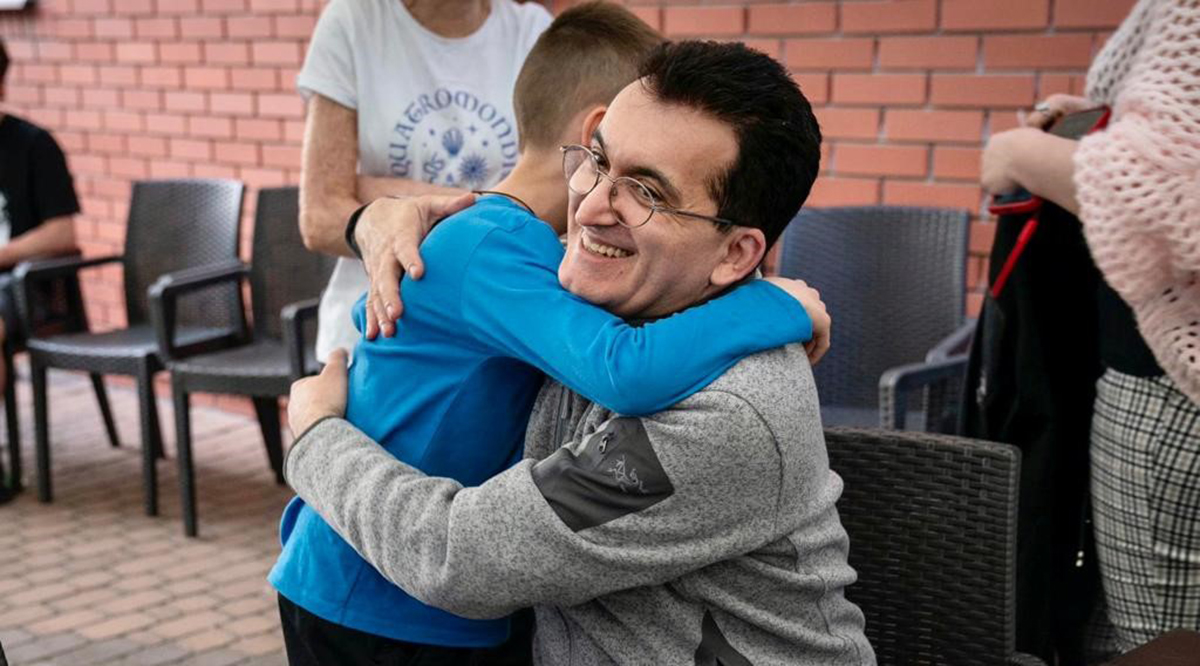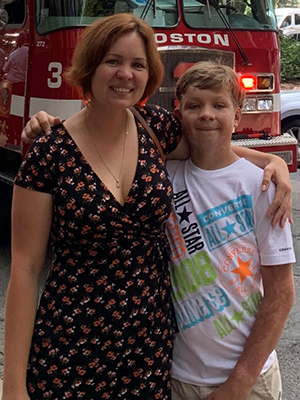
Artem Sokolov was playing outside in Kharkiv, Ukraine, in June 2022 when a bomb hit, tearing into the 10-year-old’s arm, searing his skin, and shattering crucial nerves. It also knocked him unconscious.
Despite initially spending more than three months in the hospital, Artem couldn’t fully use his hand, and nearly a year later even a small breeze could spark significant pain. He needed additional surgeries, but had little hope of getting them in his war-torn country.
In May of this year, Artem and 19 other Ukrainian children ages 2 to 19 — as well as their guardians and several Ukrainian physicians — traveled to Leczna, Poland, where the children spent five days receiving reconstructive and plastic surgery from a team of U.S. doctors.
Some of the youngsters had suffered devastating war-related wounds while others were still healing from prewar injuries, but none could get the requisite care in their homeland following Russia’s 2022 invasion. In Poland, all were treated for free as part of a medical mission spearheaded by physicians from U.S. teaching hospitals.
“It’s a privilege to help these patients and their doctors,” says Shawn Diamond, MD, a hand surgeon from Texas Tech University Health Sciences Center El Paso who joined the mission.
“What these people have experienced is unbelievable. The children are so traumatized,” he adds. “The providers showed me images of ballistic missiles going through people. They are working so hard while their own homes are being bombed. They also have very limited resources for regular care because they are trying to save the lives of soldiers.”
Working with Polish colleagues at a state hospital, the U.S. doctors performed 79 procedures, some quite intricate. Artem, for example, received microsurgery to excise a mass of scar tissue that was strangling a vital nerve.
The U.S. team continues to monitor these patients — as well as several others treated during prewar missions to Ukraine designed to provide complex care unavailable there. Such follow-up is often essential because scars can pull painfully tight as a child’s body grows.
The team also has been teaching Ukrainian providers some crucial procedures for treating war-related injuries. And it brings some of the most challenging patients to receive complex care in the United States.
“I’m passionate about this work. I think every physician who takes the Hippocratic Oath needs to give back to society. This is like my religion.”
Gennadiy Fuzaylov, MD
President and co-founder
Doctors Collaborating to Help Children
All of this patient care requires a tremendous logistical lift. The Poland mission alone entailed finding a Polish hospital willing to open its doors, travel arrangements for the families (three of which had already fled Ukraine), hotel accommodations, and more.
“This took months of negotiations with Polish, Ukrainian, and U.S. officials,” explains Gennadiy Fuzaylov, MD, an intensivist and pediatric anesthesiologist at Massachusetts General Hospital (MGH) in Boston and president and co-founder of Doctors Collaborating to Help Children (DCTOHC), which spearheaded the effort. Created after a Ukrainian physician reached out to Fuzaylov for help with a severely injured child in 2005, the nonprofit focuses largely on pediatric burn patients.
Despite the hurdles involved, Fuzaylov says he and his fellow volunteers are determined to keep helping.
“I’m passionate about this work,” he says. “I think every physician who takes the Hippocratic Oath needs to give back to society. This is like my religion.”
Journey to Poland
For the children treated in Poland, their injuries made it hard — or impossible — to perform simple, everyday tasks.
“Some of the children had scars on their necks that were so tight that it made it difficult to turn their heads,” says Jeremi Mountjoy, MD, an MGH anesthesiologist. “Hand injuries made it hard to wear gloves or type on a keyboard. One little girl had a lot of trouble just straightening her legs to walk.”
To decide which children to bring over, volunteer doctors waded through a DCTOHC-created database with crucial information, such as scar photos and medical histories. “We went through dozens of patients to figure out who should be pushed to the front of the line,” says Daniel Driscoll, MD, DCTOHC director and a Tufts Medical Center plastic surgeon. The trip prep also involved numerous discussions with the referring Ukrainian doctors and the hosting Polish providers, who generally spoke English well enough to ease the process for their U.S. colleagues.
“Hand injuries made it hard [for the children] to wear gloves or type on a keyboard. One little girl had a lot of trouble just straightening her legs to walk.”
Jeremi Mountjoy, MD
Massachusetts General Hospital
Once in Poland, most of the procedures entailed relieving tight-pulling scars, sometimes with lasers, or repairing damaged tissue, often with grafts. Artem underwent a graft to repair a ruptured nerve — nearly 3 inches were missing — in addition to the microsurgery to remove his scar tissue.
“These surgeries can be pretty life-changing,” says Mountjoy.
Also crucial for the children was the chance to meet peers with similar injuries, says Justin Knittel, MD, an anesthesiologist at Washington University School of Medicine in St. Louis. “A lot of these kids experience social isolation because of their scars. Here, though, they could find someone who looks a lot like them.”
Following surgery, the patients were screened for any complications, and the U.S. providers continue to monitor the kids’ progress from afar.
They’re also keeping an eye out for their patients and colleagues who have returned to a war zone.
“When they were driving back from Poland, we would receive constant updates, texts and photos, letting us know they were safe,” says Knittel. “When we heard the buses arrived in Ukraine, it was a big relief. … But it’s also bittersweet.”
From Ukraine to the United States
The team can only achieve so much abroad for certain children, though, so they have been bringing them to the United States for care. Since the war started, 20 children have made the trip.
Fuzaylov wishes he could bring more. “Some of these children are coming from cities that are bombed to the ground,” he says. “It’s impossible to get treatment in a city that doesn’t exist.”
So far, the children have received prosthetic devices, treatment for pain, burn scar surgeries, and other forms of complex care. They often stay for several months. “If they have multiple injuries we spread out the treatment, because it’s too painful to do more at once,” says Mountjoy.
While the families are in the United States — often in Boston to get care from MGH and Shriners Children’s Hospital specialists — the nonprofit DCTOHC provides them with a place to stay. The group also handles the travel arrangements, which can be complex.
For example, one boy required a special air ambulance to accommodate the devices that were stabilizing his legs after they were crushed in a bombing. His international journey also required stopover care in Poland as well as additional fundraising to pay for the complex transport. “Sometimes the logistics feel harder than the surgery itself,” says Fuzaylov.

Among the children treated in the United States is Dmitriy Kavun. Now 12, the boy was burned by scalding water when he was 15 months old. Not long after, he and his mother, Anna, made a 12-hour trip across Ukraine to see Fuzaylov, who was on a medical mission there. But she was told that treatment would require repeated trips to Boston; it’s been nine so far.
Three weeks after Russia invaded Ukraine, Dmitriy and Anna fled Mykolaiv, a city hit hard in the war. “As my husband was driving us to the Romanian border, Gennadiy called [from the U.S.] to see how he could help. I told him I would call him back when we were safe,” Kavun recalls. A few months later, Dmitriy was in Boston for his next treatment.
For now, the mother and son are living in Canada, though they yearn to return to their country. “The first thing for me as a mother is that I am responsible for my son’s life,” says Kavun. “I’m afraid to go back with him now.”
Meanwhile, she is deeply grateful to the doctors who have helped her son heal not just physically, but emotionally.
“Dmitriy becomes more confident because of the treatments and the support of the doctors. They are so kind with him. While we are there for surgery, Gennadiy texts us every day, asking ‘How are you?’” she says. “This care is a miracle in our lives.”
The multiplier effect
Cutting-edge training of Ukrainian providers as well as ongoing remote consultations extend the reach of the U.S. health care providers.
The team provides teleconsults to support the extensive follow-up care patients need — as well as any tough new cases colleagues face. “I’m available 24/7. Colleagues text me, and I respond within an hour,” says Fuzaylov.
One of the most significant remote efforts focuses on war-related amputation patients. Often, pain — whether from real tissue or phantom limbs — makes it impossible to provide patients with a prosthetic device, explains David Brown, MD, a plastic surgeon at Michigan Medicine in Ann Arbor who went to Poland.
Brown explains a key problem: “Nerves are like tree limbs. When they’re torn, they still want to sprout. But the nerves don’t have any place to go, so they grow neuromas, masses that are hypersensitive.”
But there is possible relief: “We can wrap skin or muscle around the nerve. If it has a place to grow into, the nerve is ‘happy’ and stops sending problematic signals to the brain.”
Brown was among those involved in developing this new technique — called regenerative peripheral nerve interface — which is not yet common even in the United States. But in November 2022, he and colleagues began teaching it to Ukrainians via teleconference and have so far trained dozens of doctors.
The education entailed such standard forms of training as lectures, but also smart glasses that allowed U.S. doctors to watch the procedure and provide real-time guidance to their Ukrainian colleagues. “It’s pretty awesome to teach a new technique without ever being present,” says Fuzaylov. What’s more, he adds, Ukrainian providers can go on to train others in their country.
The U.S. team also ships or brings crucial medical supplies, some quite innovative. During the Poland trip in May, they brought a recently invented tool that simplifies the tricky task of inserting a breathing tube.
“This device is more flexible and directable, so it can make the necessary turns more easily,” says Knittel. “It’s low-tech, requires no electricity or batteries, and training takes just a few minutes. It’s very useful in a place like Ukraine.”
Knittel and others hope to resume missions to Ukraine, but no trips are yet on the horizon. Meanwhile, they are determined to provide support as best they can to the colleagues and patients they care about and admire.
“Their country has been through so much in past decades, and it’s going through even more now. But they are a very proud, resolved, strong people,” says Mountjoy.
“Even the children are amazingly resilient. If I think about my own children if they had to go to a foreign country for treatment like these kids, I can imagine how terrified they might be. But the Ukrainian children were incredibly brave and strong.”
